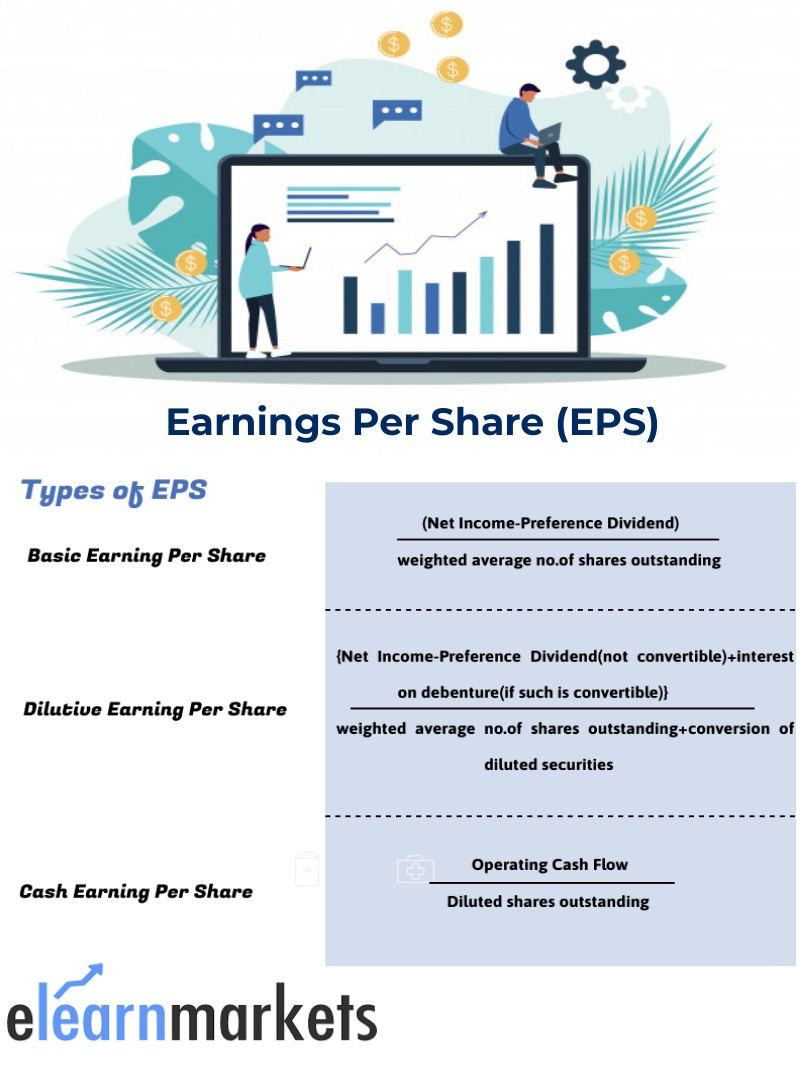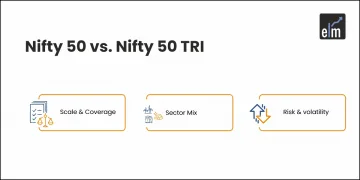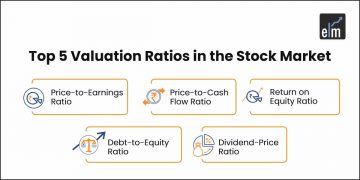| Table of Contents |
|---|
| What is Earning Per Share (EPS) |
| Why Earnings Per Share is Important? |
| What is Earning Per Share Growth? |
| Formula |
| Factors Affecting Earning Per Share |
| Impact |
There are a lot of ratios that help the investor to make any investment decision; one such ratio is the earning per share which depicts the efficiency of a company in generating profits from its business venture.
What is Earning Per Share (EPS)?
EPS measures the amount of net income earned per share of stock outstanding. In other words, this is the amount of money each share of stock would receive if all of the profits were distributed to the outstanding shareholders at the end of the year.
A large company’s profits per share cannot be compared to a small company’s profits per share. A larger company will have to split its earnings amongst many more shares of stockholders compared to a smaller company.

Why Earnings Per Share is Important?
EPS is very important for all the investors as it indicates that how much income is being earned by each ordinary shareholder. It gives an understanding of the profitability of the company.
Investors use earnings per share to compare with the share price of the shares to determine the value of earning and how shareholders feel about the future growth of the company.
In order to determine the value of earning from the share, shareholders also calculate EPS in two different ways:
- Basic Earnings Per Share
- Diluted Earnings Per Share
- Cash earnings per share
1. Basic EPS
Basic EPS does not take into account any dilutive effect that convertible securities have on its EPS.
For example, it does not take into account any right issue or bonus issue. i.e the company offers extra shares to its shareholders.
2. Diluted EPS
Basic earnings per share take into account only those shares in an issue that were outstanding during the period.
Sometimes in the future company may have entered into obligations that could have diluted the EPS in the future.
Learn from Market Experts – Macroeconomics made Easy
So, basic earnings per share should be adjusted for the effect of all the dilutive potential ordinary shares.
3. Cash EPS
Cash EPS or more commonly operating cash flow per share measures the financial performance of the company.
Free from non-cash items like depreciation which is included in basic EPS calculation, cash EPS may prove to be a more reliable measure of the financial and operational health of the company. The higher the company’s cash EPS, the better it is considered to have performed over a period.
What is Earning Per Share Growth?
Growth in earning per share indicates that by what percentage the earning per share has been increasing in comparison to the previous 12 months.
A higher ratio indicates that the company’s profitability has increased and it is running its business efficiently.
On the other hand lower ratio indicates that the company’s profit has reduced and is not utilizing the funds efficiently.
Formula:
Earnings per share or basic earnings per share is calculated as net income after subtracting preferred dividend divided by the weighted average number of common shares outstanding.
Basic Earning Per Share – (Net income – Preference dividend) / Weighted average no of share outstanding
Diluted Earning Per Share– {Net income – preference dividend (which are not convertible) + Interest on debenture (if such debenture is convertible)} / (Weighted average no of share outstanding + conversion of diluted securities)
Cash Earning Per Share– (Operating cash flow / Diluted shares outstanding)
Factors Affecting Earning Per Share:
Earning per share gets affected by various factors.
- When earnings of the company increases this affects the EPS positively as it also increases.
- Earnings per share increases when the total number of outstanding share decreases in case of buyback.
- When expenses decreases and company is able to cut the cost then also the earnings of the company increases with increase in sales.
- Earnings per share decreases when company issues new shares which affect the earnings per share negatively for example in case of rights and bonus.
Let us understand this with a particular example.
Company: – Indiamart Intermesh Ltd.
| FY19 | FY20 | |
| NET PROFIT AFTER TAX (in crores) | 20 | 149 |
| NO. OF SHARES OUTSTANDING(in crores) | 2892.89 | 2.892.89 |
| EARNING PER SHARE | 7.03 | 51 |
| GROWTH ON EARNING PER SHARE | = ((51-7.03)/7.03)*100 | |
| = 625 % |
As on March’20 net profit has increased from Rs. 20 crore to Rs.149 crore thus the EPS also saw a whopping growth. Overall company’s profitability increased and also its growth which gives a positive view to its shareholders.
Impact
Since investors keep an eye on the share price of all the listed companies increasing EPS attracts investors as they like to invest in companies whose earnings are on a constant rise.
This shows that the company is utilizing the funds of the shareholders efficiently and providing them with a good return.
Negative or lower earnings per share do not attract investors and give a poor indication about the future of the company.
Let us understand this with an example.
Company: – Bharti Airtel
| FY19 | FY20 | |
| NET PROFIT AFTER TAX (in crores) | 409.5 | -32183.2 |
| NO. OF SHARES OUTSTANDING (in crores) | 545.56 | 545.56 |
| EARNING PER SHARE | 0.94 | -58.99 |
| GROWTH ON EARNING PER SHARE | = ((-58.99-0.94)/0.94)*100 | |
| = -6375% |
This reduces the interest of the shareholders as it indicates that the company is not running the business and utilizing the funds efficiently.
It is not giving a good picture of the company for the future growth potential.
Thus it does not attract the investor community.
Thus this is how EPS forms a very important metric for investment destination.
Key Takeaways:
- Earnings per share indicate how much money a company makes for each of its shareholders.
- EPS Growth is the percentage change in earning per share of the current year from the earnings per share of previous year.
- A higher or increasing earnings per share indicates that the company is earning more profits to distribute to its shareholders.
- Higher or increasing growth on EPS gives a good indication about the company’s efficiency on its business prospects.
- Lower or decreasing EPS gives poor indication about the health of the company and gives lower return to the shareholders.
- Lower or decreasing growth on EPS gives poor indication about the company’s future growth prospect.
Happy Learning!
In order to get the latest updates on Financial markets visit StockEdge.com






